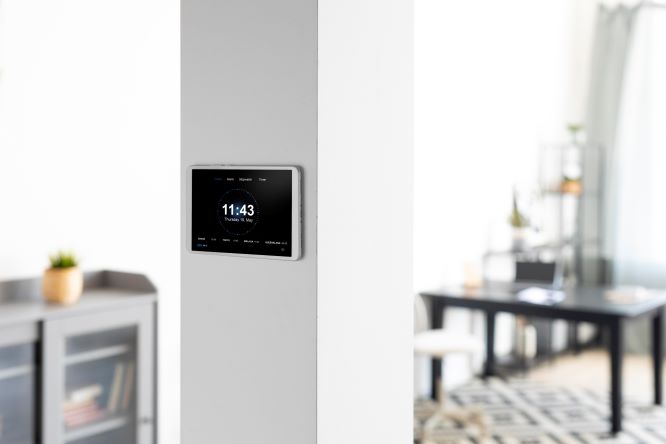Why Upgrade to a Smart Thermostat Without a C Wire?
Have you ever wondered how a smart thermostat could revolutionize your home’s comfort and energy efficiency? Smart thermostats are one of the most popular upgrades for modern homes, offering features like remote control, energy savings, and seamless integration with smart home systems. However, for many homeowners, the excitement of upgrading to a smart thermostat is quickly dampened by a common issue: the lack of a C wire.
The C wire, or “common wire,” is a critical component in many HVAC systems, providing continuous power to smart thermostats. Unfortunately, many older homes lack this wire, making installation seem like a daunting task. But don’t worry—there are solutions! In this guide, we’ll explore everything you need to know about installing a smart thermostat without a C wire, from understanding what a C wire is to finding the best thermostats and workarounds for your home.
Section 1: Understanding the C Wire
What Is a C Wire?
The C wire, short for “common wire,” is a low-voltage wire that provides continuous power to your thermostat. Unlike traditional thermostats that rely on batteries or intermittent power from other wires, smart thermostats require a constant power source to support advanced features like Wi-Fi connectivity, touchscreens, and learning algorithms.
In most HVAC systems, the C wire connects directly to the thermostat and the HVAC control board, ensuring that the thermostat has a steady flow of electricity. Without it, many smart thermostats may not function properly or may experience issues like power cycling.
Why Do Many Homes Lack a C Wire?
Many older homes, particularly those built before the 1990s, were designed with simpler HVAC systems that didn’t require a C wire. Traditional thermostats operated on minimal power, often supplied by batteries or other wires like the R (power) and W (heat) wires. As a result, the C wire wasn’t included in these systems.
To determine if your home has a C wire, you can remove your existing thermostat’s faceplate and check the wiring. Look for a wire connected to the terminal labeled “C.” If there’s no wire or the terminal is empty, your system likely lacks a C wire.
Do All Smart Thermostats Require a C Wire?
Not all smart thermostats require a C wire. Some models are designed to work without one by using alternative power sources, such as power-stealing technology or built-in batteries. However, these solutions may come with limitations, such as reduced functionality or compatibility issues with certain HVAC systems.
Section 2: Challenges of Installing a Smart Thermostat Without a C Wire
Installing a smart thermostat without a C wire can present several challenges, including:
- Power Cycling Issues: Without a constant power source, some thermostats may turn on and off repeatedly, leading to inconsistent performance.
- Limited Features: Certain features, like Wi-Fi connectivity and advanced scheduling, may not work without adequate power.
- Increased Installation Costs: Adding a C wire to your system often requires professional installation, which can be expensive and time-consuming.
These challenges can make the process seem overwhelming, but there are practical solutions to overcome them.
Section 3: Solutions and Workarounds
Thermostats Designed for No C Wire
Several smart thermostats are specifically designed to work without a C wire. These models use innovative technologies to draw power from existing wires or include built-in batteries. Popular options include:
- Nest Thermostat (2020 model): Uses power-stealing technology to operate without a C wire.
- ecobee3 Lite: Compatible with a power extender kit for systems without a C wire.
- Honeywell Home T9: Offers flexible installation options and works with most HVAC systems.
These thermostats are ideal for homeowners who want to avoid the hassle of adding a C wire.
Using a C Wire Adapter or Power Extender Kit
A C wire adapter, also known as a power extender kit, is a simple and cost-effective solution for systems without a C wire. These devices create a virtual C wire by redistributing power from existing wires. Here’s how they work:
- Connect the adapter to your HVAC control board.
- Attach the adapter’s wires to the thermostat terminals.
- Follow the manufacturer’s instructions to complete the setup.
C wire adapters are easy to install and compatible with most smart thermostats, making them a popular choice for DIY enthusiasts.
Alternative Wiring Methods
If you’re comfortable with basic electrical work, you can try alternative wiring methods, such as:
- Repurposing an Existing Wire: Convert an unused wire, like the G (fan) wire, into a C wire. This method requires reconfiguring your HVAC control board and thermostat wiring.
- Using the G Wire Hack: Temporarily use the G wire as a C wire. While this method works in some cases, it may disable your fan’s independent operation.
For complex systems or if you’re unsure about wiring, it’s best to hire a professional HVAC technician.
Section 4: Best Smart Thermostats Without a C Wire (Buyer’s Guide)
When choosing a smart thermostat for a system without a C wire, consider factors like compatibility, features, and ease of installation. Here are some top models:
| Model | Price | Features | Compatibility | Ease of Installation |
|---|---|---|---|---|
| Nest Thermostat | $129 | Energy-saving, app control | Most HVAC systems | Easy |
| ecobee3 Lite | $149 | Smart sensors, Alexa integration | Requires power extender | Moderate |
| Honeywell Home T9 | $199 | Room sensors, geofencing | Most HVAC systems | Easy |
| Emerson Sensi Touch | $169 | Touchscreen, Wi-Fi | Most HVAC systems | Easy |
| Lux Kono Smart | $139 | Customizable design, app control | Limited compatibility | Moderate |
Each of these thermostats offers unique benefits, so choose one that best fits your needs and budget.
Section 5: Installation Guide (General Overview)
Installing a smart thermostat without a C wire is easier than you might think. Here’s a high-level guide:
- Check Compatibility: Ensure your HVAC system is compatible with the thermostat you’ve chosen.
- Turn Off Power: Switch off power to your HVAC system at the circuit breaker.
- Remove Old Thermostat: Carefully disconnect the wires and label them for reference.
- Install the New Thermostat: Follow the manufacturer’s instructions to connect the wires and mount the thermostat.
- Power On and Test: Restore power and test the thermostat to ensure it’s working correctly.
If you encounter any issues, consult the thermostat’s manual or contact customer support.
Section 6: Common Questions and Troubleshooting
FAQs
- Will a smart thermostat work if I don’t have a C wire?
Yes, many smart thermostats are designed to work without a C wire using alternative power solutions. - What are the risks of not using a C wire?
Without a C wire, your thermostat may experience power cycling or limited functionality. - How can I tell if my thermostat is getting enough power?
Check the thermostat’s display and features. If it’s not functioning properly, it may not be receiving adequate power.
Troubleshooting Tips
- Power Loss: Ensure all wires are securely connected and check your HVAC system’s power supply.
- Connectivity Issues: Restart your Wi-Fi router and thermostat.
- Erratic Behavior: Update the thermostat’s firmware or reset it to factory settings.
Section 7: Benefits and Drawbacks of Installing a Smart Thermostat Without a C Wire
Benefits
- Energy Efficiency: Save on energy bills with advanced scheduling and learning features.
- Convenience: Control your thermostat remotely via smartphone apps.
- Comfort: Maintain consistent temperatures throughout your home.
Drawbacks
- Limited Features: Some thermostats may not support all features without a C wire.
- Potential Issues: Power cycling and compatibility problems can occur.
Conclusion
Upgrading to a smart thermostat without a C wire doesn’t have to be complicated. With the right thermostat, workarounds like C wire adapters, and a little preparation, you can enjoy the benefits of a smart home without the hassle of rewiring your HVAC system. Whether you choose a model designed for no C wire or opt for a simple adapter, there’s a solution for every homeowner.



